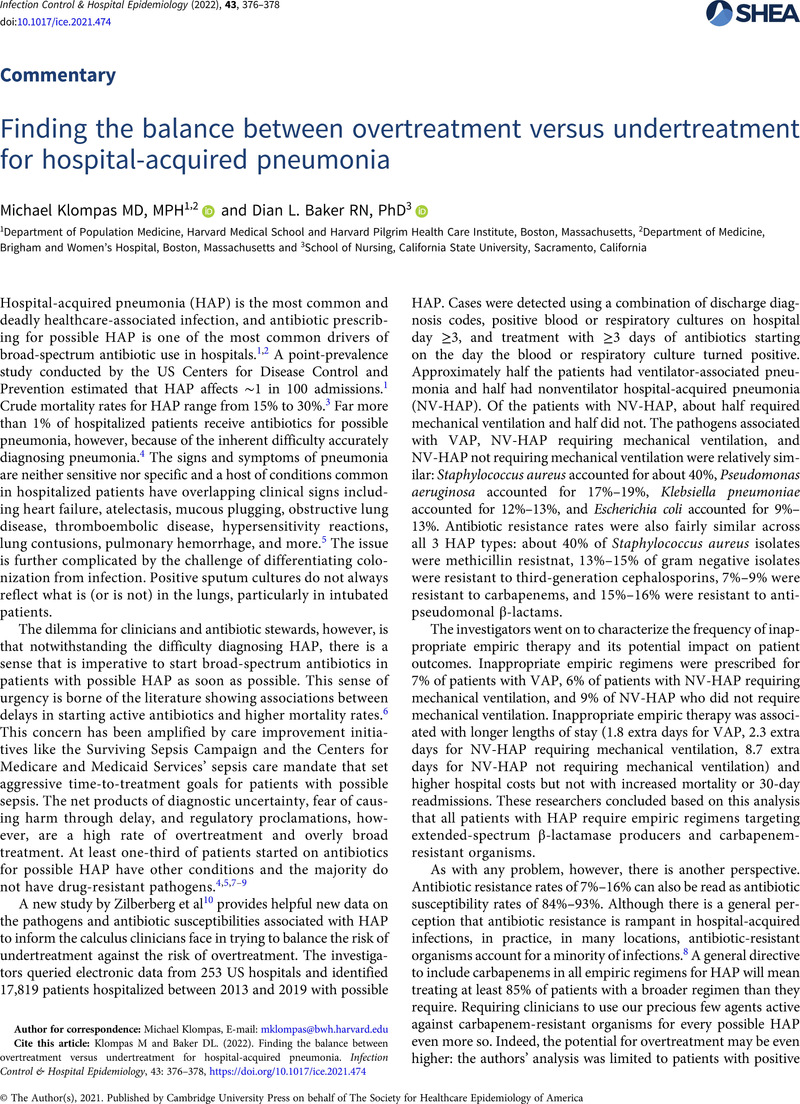No CrossRef data available.
Article contents
Finding the balance between overtreatment versus undertreatment for hospital-acquired pneumonia
Published online by Cambridge University Press: 01 December 2021
Abstract
An abstract is not available for this content so a preview has been provided. Please use the Get access link above for information on how to access this content.

- Type
- Commentary
- Information
- Copyright
- © The Author(s), 2021. Published by Cambridge University Press on behalf of The Society for Healthcare Epidemiology of America
References
Magill, SS, O’Leary, E, Janelle, SJ, et al. Changes in prevalence of healthcare-associated Infections in US hospitals. N Engl J Med 2018;379:1732–1744.Google Scholar
Magill, SS, O’Leary, E, Ray, SM, et al. Antimicrobial use in US hospitals: comparison of results from emerging infections program prevalence surveys, 2015 and 2011. Clin Infect Dis 2021;72:1784–1792.Google Scholar
Corrado, RE, Lee, D, Lucero, DE, Varma, JK, Vora, NM. Burden of adult community-acquired, health-care-associated, hospital-acquired, and ventilator-associated pneumonia: New York City, 2010 to 2014. Chest 2017;152:930–942.Google ScholarPubMed
Klompas, M. Does this patient have ventilator-associated pneumonia? JAMA 2007;297:1583–1593.Google ScholarPubMed
Fernando, SM, Tran, A, Cheng, W, et al. Diagnosis of ventilator-associated pneumonia in critically ill adult patients-a systematic review and meta-analysis. Intensive Care Med 2020;46:1170–1179.Google ScholarPubMed
Kuti, EL, Patel, AA, Coleman, CI. Impact of inappropriate antibiotic therapy on mortality in patients with ventilator-associated pneumonia and blood stream infection: a meta-analysis. J Crit Care 2008;23:91–100.Google ScholarPubMed
Tejerina, E, Esteban, A, Fernandez-Segoviano, P, et al. Accuracy of clinical definitions of ventilator-associated pneumonia: comparison with autopsy findings. J Crit Care 2010;25:62–68.Google ScholarPubMed
Weiner-Lastinger, LM, Abner, S, Edwards, JR, et al. Antimicrobial-resistant pathogens associated with adult healthcare-associated infections: summary of data reported to the National Healthcare Safety Network, 2015–2017. Infect Control Hosp Epidemiol 2020;41:1–18.Google Scholar
Bergin, SP, Coles, A, Calvert, SB et al. PROPHETIC: Prospective Identification of Pneumonia in Hospitalized Patients in the ICU. Chest 2020; 158: 2370-2380
Google ScholarPubMed
Zilberberg, MD, Nathanson, BH, Puzniak, LA, Shorr, A. Microbiology, empiric therapy and its impact on the outcomes of non-ventilated hospital-acquired, ventilated hospital-acquired, and ventilator-associated bacterial pneumonia in the United States, 2014–2019. Infect Control Hosp Epidemiol 2021.
Google Scholar
Micek, ST, Chew, B, Hampton, N, Kollef, MH. A case-control study assessing the impact of nonventilated hospital-acquired pneumonia on patient outcomes. Chest 2016;150:1008–1014.Google ScholarPubMed
Hong, HL, Hong, SB, Ko, GB, et al. Viral infection is not uncommon in adult patients with severe hospital-acquired pneumonia. PLoS One 2014;9:e95865.Google ScholarPubMed
Chow, EJ, Mermel, LA. Hospital-acquired respiratory viral infections: incidence, morbidity, and mortality in pediatric and adult patients. Open Forum Infect Dis 2017;4:ofx006.Google ScholarPubMed
Rhee, C, Kadri, SS, Dekker, JP, et al. Prevalence of antibiotic-resistant pathogens in culture-proven sepsis and outcomes associated with inadequate and broad-spectrum empiric antibiotic use. JAMA Netw Open 2020;3:e202899.Google ScholarPubMed
Jones, BE, Ying, J, Stevens, V, et al. Empirical anti-MRSA vs standard antibiotic therapy and risk of 30-day mortality in patients hospitalized for pneumonia. JAMA Intern Med 2020;180:552–560.Google ScholarPubMed
Klompas, M, Calandra, T, Singer, M. Antibiotics for sepsis-finding the equilibrium. JAMA 2018;320:1433–1434.Google ScholarPubMed
Prescott, HC, Iwashyna, TJ. Improving sepsis treatment by embracing diagnostic uncertainty. Ann Am Thorac Soc 2019;16:426–429.Google ScholarPubMed
Fagon, JY, Chastre, J, Wolff, M, et al. Invasive and noninvasive strategies for management of suspected ventilator-associated pneumonia: a randomized trial. Ann Intern Med 2000;132:621–630.Google ScholarPubMed
Hranjec, T, Rosenberger, LH, Swenson, B, et al. Aggressive versus conservative initiation of antimicrobial treatment in critically ill surgical patients with suspected intensive-care-unit-acquired infection: a quasi-experimental, before and after observational cohort study. Lancet Infect Dis 2012;12:774–780.Google ScholarPubMed
Ramsamy, Y, Muckart, DJ, Bruce, JL, Hardcastle, TC, Han, KS, Mlisana, KP. Empirical antimicrobial therapy for probable v. directed therapy for possible ventilator-associated pneumonia in critically injured patients. S Afr Med J 2016;106:196–200.Google ScholarPubMed
Evans, L, Rhodes, A, Alhazzani, W, et al. Surviving sepsis campaign: international guidelines for management of sepsis and septic shock 2021. Crit Care Med 2021;49:e1063–e1143.Google ScholarPubMed
Zilberberg, MD, Nathanson, BH, Puzniak, LA, Shorr, AF. Descriptive epidemiology and outcomes of nonventilated hospital-acquired, ventilated hospital-acquired, and ventilator-associated bacterial pneumonia in the United States, 2012–2019. Crit Care Med 2021. doi: 10.1097/CCM.0000000000005298.Google Scholar
Munro, SC, Baker, D, Giuliano, KK, et al. Nonventilator hospital-acquired pneumonia: a call to action. Infect Control Hosp Epidemiol 2021;42:991–996.Google ScholarPubMed
Lacerna, CC, Patey, D, Block, L, et al. A successful program preventing nonventilator hospital-acquired pneumonia in a large hospital system. Infect Control Hosp Epidemiol 2020;41:547–552.Google Scholar



